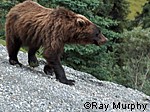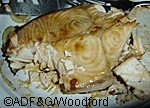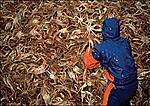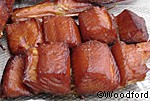Alaska Fish & Wildlife News
October 2006
One Bear, Two Bears, Three Bears…
Counting Bears You Can Not See

Al Keech slung the shotgun over his shoulder as he strolled through the woods towards the grizzly bear lure site. I stayed close, trying to make noise as we approached the blood-and-fish soaked lure. I knew hundreds of these sites had been checked over the summer without any encounters with bears but still, it was a grizzly bear lure site, and it was the first I was checking.
It wasn't bears we were looking for, but evidence of bears. “We got one,” I said to Keech, peering at the clump ...
Counting Bears ArticleContinued
White King Salmon
Greenbacks, Gustatory Preference and Genetics

The rich, red meat of a wild Alaska king salmon is a vivid sight. Translucent and buttery, the deep red color comes from pigments in crustaceans in the salmons' diet. Some king salmon – about one in 20 – have white meat due to an inability to process these pigments in their food. Although these white kings have long been coveted by many Alaskans, the pale meat typically fetched a lower price from fish buyers and was considered commercially less desirable. But now white kings are making a splash ... White King ArticleContinued
Wood Bison Restoration in Alaska

A few hundred years ago, massive wood bison and musk oxen roamed the meadows of Interior Alaska. Steller sea cows and spectacled cormorants inhabited Aleutian waters. But by 1900, these animals were gone.
It's too late to bring back the Steller sea cow and the spectacled cormorant – these animals are extinct. And while musk oxen and wood bison were extirpated from Alaska, populations survived in Greenland and Canada. In the 1930s, musk oxen were reintroduced to Alaska, and now several thousand ...
Wood Bison to Return ArticleContinued
Fish Tickets
Fishery Database is the Envy of the Industry

In the global fishery market, Alaska stands out as a giant. We have, arguably, one of the best managed fisheries in the world. Fish tickets play a large role in gathering the data that make this possible.
Fish tickets document the harvest of fish and shellfish sold, discarded, or retained by the fisherman for personal use. All licensed processors must fill out a fish ticket for each landing from a fishing permit holder. Fish tickets are a record of purchase between the processors (or buyers) ...
Managing Fish ArticleContinued
eLandings - Fish Tickets go Electronic

Every year, the Alaska Department of Fish and Game (ADF&G), Division of Commercial Fisheries, prints hundreds of thousands of paper fish tickets to distribute to fish processors. For years, there was talk of the day when we would compile fish ticket data electronically … and then we'd go ahead and order more paper fish tickets.
According to Eric Reiter, Seafood Industry Coordinator at ADF&G, between 200,000 and 430,000 4-ply printed fish tickets are ordered every year. The current inventory ...
eLandings ArticleContinued
Simple Smoked Salmon

This is a good, economical, easy and fairly quick method for preparing smoked salmon. The key is dry brining and letting the surface of the fish dry well before you smoke it.
With your average coho or sockeye, this will provide nice, thick chunks of oily smoked salmon (the thick parts of the fillets), and drier, thinner pieces (the section near the tail). I cut the thicker fillets lengthwise through the meat, but not through the skin, so the meat is scored and the dry brine and air can ... Smoked Salmon Article Continued
